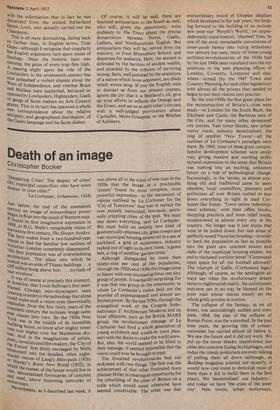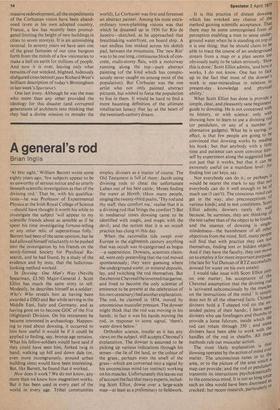Death of an image
Christopher Booker 'Despairing Cities! The despair of cities! Oh! municipal councillors who have sown despair in your cities!"
Le Corbusier, (jrbanissue, 1924) Just before the end of the nineteenth century an image of extraordinary power began to float into the mind of Western man. If found its first imaginative expression in 1,898, in H.G. Wells's remarkable vision of ,tne twenty-first century, The Sleeper Awakes. The hero wakes from a two-hundred-year trance to find the familiar low outlines of Victorian London completely disappeared. 'His first impression was of overwhelming .architecture. The place into which he looked was an aisle of Titanic buildings • . a cliff edifice hung above him. . . myriads of vast windows'. .It was of course at precisely this moment, 1,11 America, that Louis Sullivan's first steeltrarned Chicago mini-skyscrapers were creating in embryo the technology that alone could make such a vision even theoretically _realisable. Over the first thirty years of the twentieth century the inchoate image came Zer clearer into view. By the 1920s New r),rk was in the middle of its incredible ;kidding boom, as tower after mighty tower Pse ever higher over the Manhattan skyline, And in the imaginations of artists,
Poets, novelists and film-makers, the 'City of
the Future' first dimly envisaged by Wells blossomed into the detailed, often nightMarish visions of Lang's Metropolis (1926) Or Huxley's Brave New World (1932), in Which the masses of the future would live in :aSt, dehumanised formicaries of concrete and Steel, above humming networks of motorways. Nevertheless, as I described last week, it was above all in the mind of one man in the 1920s that the image as a practicable 'dream' found its most complete, most powerful expression—in the succession of visions outlined by Le Corbusier for the 'City of Tomorrow' that was to replace the now entirely outmoded, low-scale, spiritually crippling cities of the past. We must tear down everything, said Le Corbusier. We must build an entirely new kind of geometrically-planned city, great towers and vast municipal housing
estates set in a sea of parkland, a grid of motorways, industry tucked out of sight in its own 'zone,' a green belt, a ring of satellite 'garden cities.'
Although disregarded by more than ninety-nine per cent of the population, through the 1920s and 1930s this image came to haunt with ever-increasing force one tiny group of people. It was hardly surprising, for it was that one group in the community to whom Le Corbusier's vision held out the promise of unprecedented and almost unlimited power. By the late 19305, through the evangelical work of the Congres Internationaux d' Architecture Moderne and its local offshoots, such as the British MARS group, the revolutionary message of Le Corbusier had fired a whole generation of young architects and would-be town planners with the desire to make the world anew. But, alas, the world seemed to be blind to their message: it seemed impossible that the vision could ever be brought to pass.
The thwarted revolutionaries had not reckoned with two things. The first was the achievement of that other frustrated town planner Hitler in creating an opportunity for the rebuilding of the cities of Britain on a scale which would never otherwise have seemed conceivable. The other was that
extraordinary mood of Utopian idealism which developed in the war years, the looking forward to the building of an entirely new post-war 'People's World,' on unprecedentedly experimental, 'planned' lines. In one of the most remarkable conversions of avant-garde heresy into ruling orthodoxy our century has seen, many of those young architect-revolutionaries of the 1930s had by the late 1940s been translated into the top positions in the new planning offices of London, Coventry, Liverpool and elsewhere—armed (by the 1947 Town and Country Planning Act and other legislation) with almost all the powers they needed to begin to put their visions into practice.
By the mid-1950s the first great plans for the reconstruction of Britain's cities were ready—in London for the South Bank, the Elephant and Castle, the Barbican area of the City, and for many other devastated city centres. Vast tower blocks, new urban motor roads, industry decentralised, the ring of satellite 'New Towns'—all the outlines of Le Corbusier's paradigm were there. By 1960, most of these great comprehensive development schemes were under way, giving massive and startling architectural expression to the sense that Britain was rushing into an exciting, unknown future on a tide of technological change. Increasingly, in the 'sixties, as almost anything old and traditional came to seem obsolete, local councillors, planners and politicians all over Britain rushed to tear down everything in sight in mad Corbusier-like frenzy. 'Town centre redevelopment schemes,' with their office blocks, shopping precincts and inner relief roads, mushroomed in almost every city in the country. No longer was it just slums that were to be pulled down, but vast areas of perfectly sound Victorian housing—in order to herd the population as fast as possible into the giant new concrete towers and slabs of the municipal housing estates. An end to the hated 'corridor street' ! Communal open space for all (no football allowed)! The triumph of Gallic (Corbusian) logic! Although, of course, as the apologists always say when the revolutionary dream turns to nightmarish reality, the unfortunate outcome can in no way be blamed on the poor man whose visions merely set the whole grisly process in motion.
The collapse of the fantasy, as we all know, was astonishingly sudden and complete. 1968, the year of the collapse of Ronan Point, was the watershed. In the past nine years, the growing tide of conservationism has carried almost all before it. We saw the future and it did not work. We put up the tower blocks, transformed our cities into concrete Gulag Archipelagos, and today the trendy politicians are even talking of pulling them all down (although, as Building magazine pointed out recently, it would now cost more to demolish most of them than it did to build them in the first place). We 'decentralised' our industry— and today we have 'the crisis of the inner city'. New towns, urban motorways, massive redevelopment, all the impedimenta of the Corbusian vision have been abandoned (even in his own adopted country, France,. a law has recently been promulgated limiting the height of new buildings in cities to seven storeys). It is an astonishing reversal. In seventy years we have seen one of the great fantasies of our time burgeon forth from the minds of a few visionaries to make a hell on earth for millions of people. And now it is over, leaving only what remains of our wrecked, blighted, hideously disfigured cities behind ( pace Richard West's brilliant description of today's Birmingham in last week's Spectator).
One last irony. Although he was the man who more than any other provided the ideology for this disaster (and corrupted generations of architects into thinking that they had a divine mission to remake the world), Le Corbusier was first and foremost an abstract painter. Among his most extraordinary town-planning visions was that which he dreamed up in 1936 for Rio de Janeiro—sketched, as he approached that breathtaking waterfront, on board ship. A vast endless line snaked across his sketch pad, between the mountains. The 'new Rio' was to be one long, continuous block of concrete, multi-storey flats, with a motorway running along the top—pure abstract painting (of the kind which has conspicuously never caught on among most of the population). But Corbusier was the one artist who not only painted abstract pictures, but wished to force the population to live in them. It would be hard to find a more haunting definition of the ultimate totalitarian lunacy that lay at the heart of the twentieth-century dream.







































 Previous page
Previous page